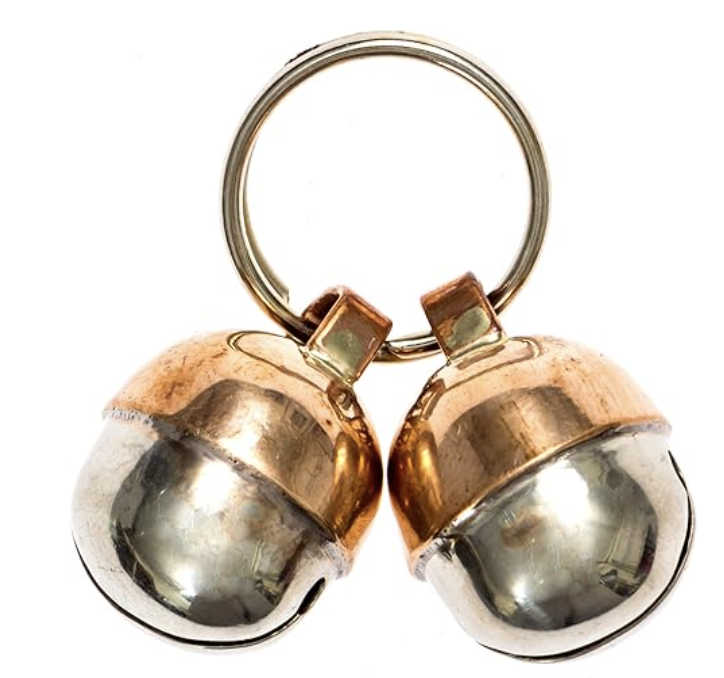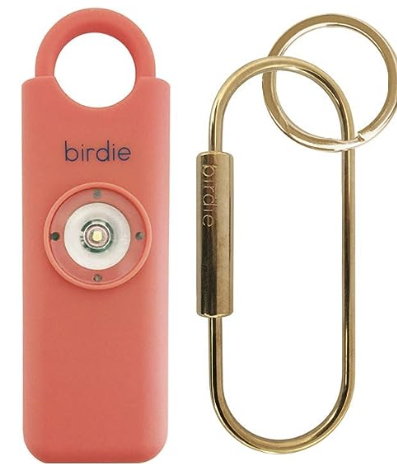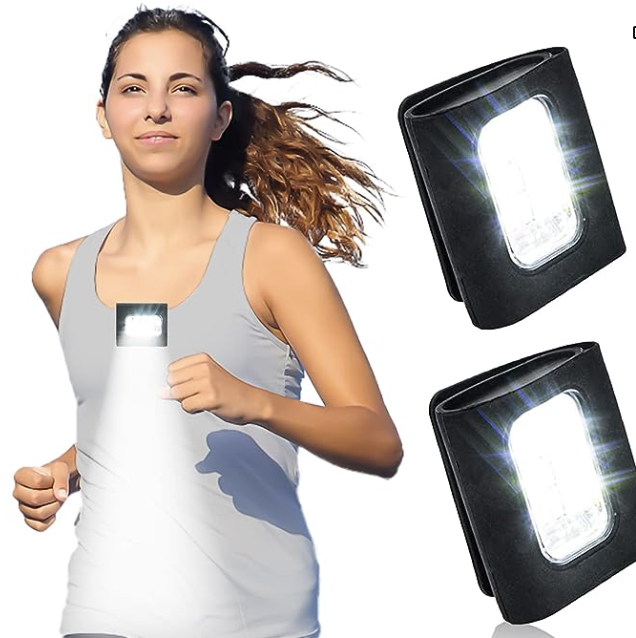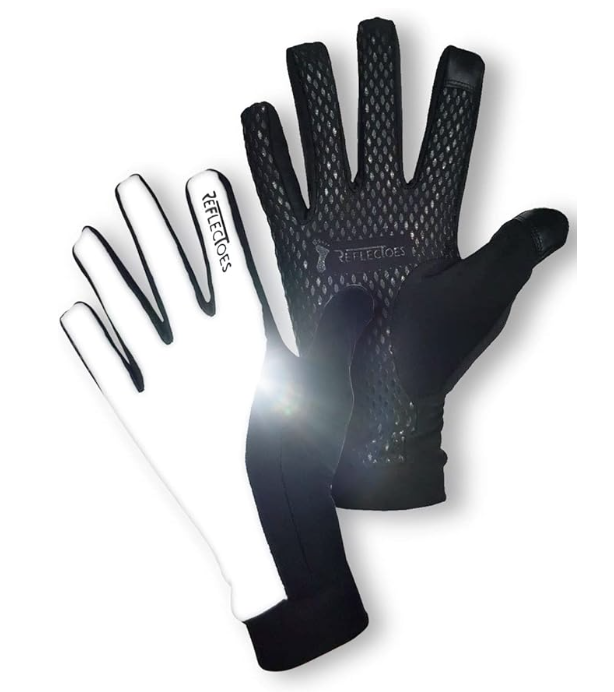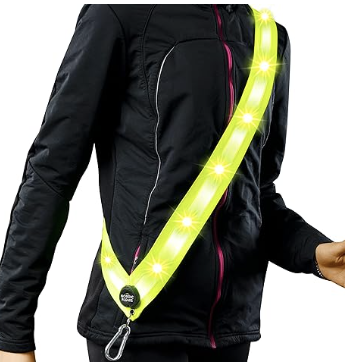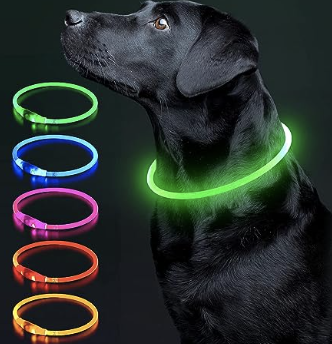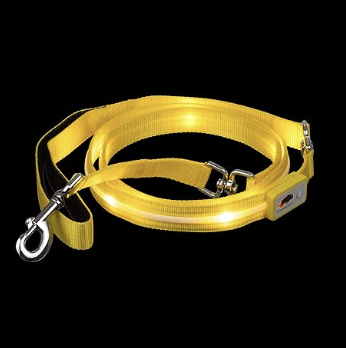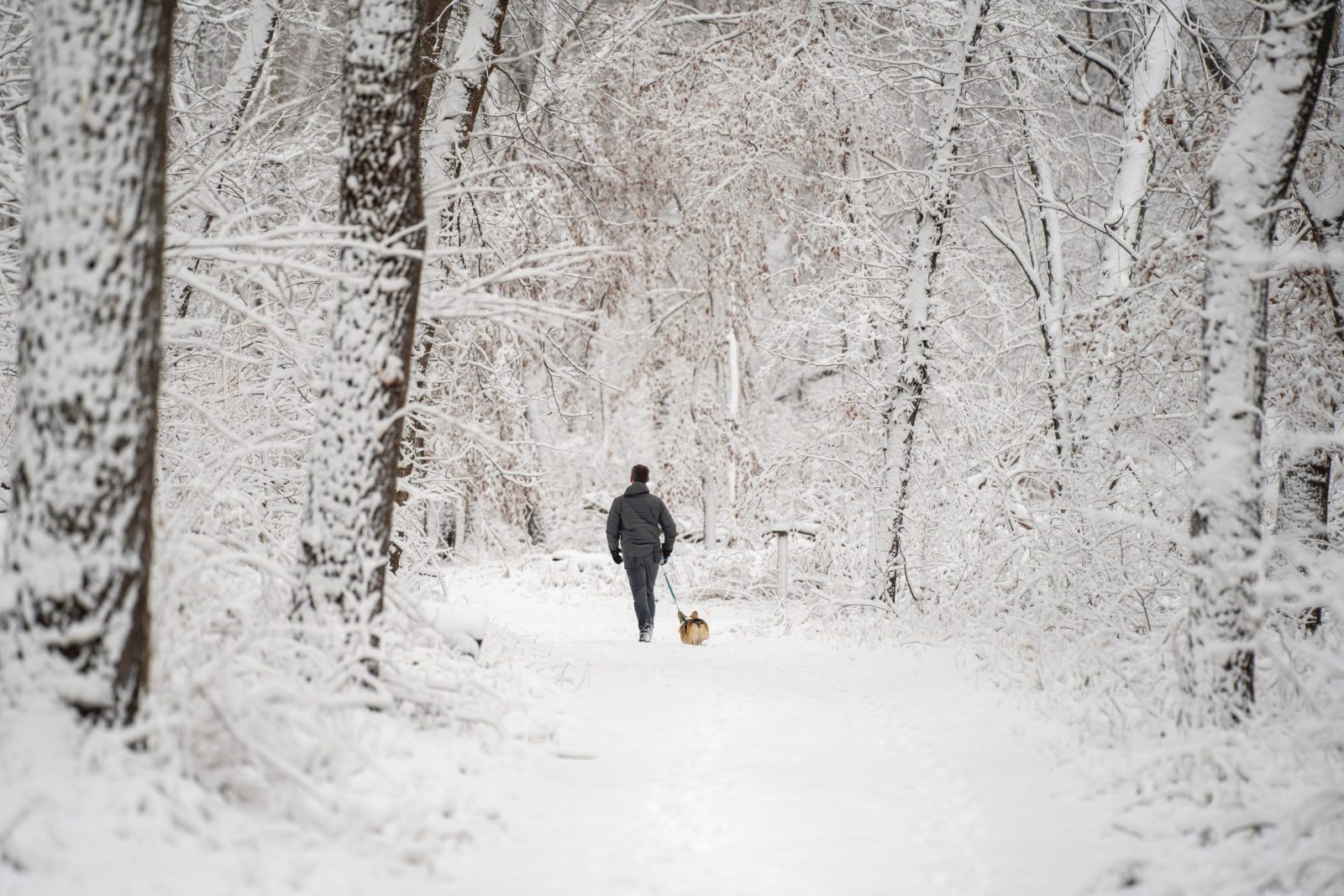2100 Words, 7 minute read for this post on dog walking in the dark.

Small Bites: The Summary Version of Dog Walking in the Dark
- Mindset Shift: Challenge the notion that walking dogs in the dark can’t be done.
- Consistent Habits: Commit to predawn or evening walks for physical and mental health, serene experiences with nature, and important bonding.
- Safety First: But, beware of speeding commuters and the increased risks posed by darkness.
- Pedestrian Statistics: 76% of pedestrian deaths happen after dark.
- Injury Trends: Older adults face increasing fracture risks with nighttime dog walking.
- State Safety Variations: Check pedestrian/vehicle collision stats for your area.
- Essential Safety Tips:
- Stay alert: No earbuds or phone distractions.
- Share your location or maintain a regular route.
- Always face oncoming traffic.
- Use headlamps or flashlights; be wary of unfamiliar routes.
- Illuminate both yourself and your dog.
- Recognize and address your dog’s potential fears of the dark.
- Consider personal safety devices for areas with crime or wildlife concerns.
- Main Goal: Ensure safety for both you and your pet.
Nighttime Dog Walks: Safety From After Sundown to Before Sunup
Last month, I was editing a chapter in my upcoming essential guide for small dog care (it’s a sequel of sorts to Downward Sizing Dog), and one of my sentences stopped me cold.
The excerpt was in the “daily habits” chapter, and I was offering excuses about how I simply can’t walk the girls in winter during the school week because it’s dark.
Really? I “can’t”??
That moment, I pushed myself to flip my thinking. What if I pretended this walking-even-when-it’s-dark-on-school-days was a matter of life or death? What would it take to get us safely out there?
As it turns out, not that much.
And this past month has proven to me that dog walking in the dark can be both safe AND a great deal of fun.
The very next day, I started rising earlier to fit in a twenty-minute walk with the girls. Aside from some torrential rainstorm days, we’ve been walking every single morning since.

Embracing Dawn: Early Morning Adventures
What began as a personal challenge shifted quickly to a one-with-nature experience we all love. This new walk in the wee hours is now probably my favorite part of the day.
Of course, we invariably encounter several speeding commuters, apparently already late for their destinations. But, for the most part, this dog walking in the dark grants us a peaceful glimpse into a natural world we don’t often see. We pass the widowed mute swan who lost his long-time mate to an enormous snapping turtle last Spring. I always worry he’s lonely, but before the sun is up, I’m comforted to see him sound asleep, his head tucked in tight under his massive wing. He’s surrounded by the resident ducks who are his family now, and they’re likewise not yet awake. We enjoy the sudden silence that descends as we approach and the crickets shut down their chirping. And I look up to enjoy the gulls, who I swear never sleep, surfing the wind.
In all of this, Phoebe, Scout, and I share a beautiful entry into our day. Yet these little encounters will disappear as it will soon become pitch black when we venture out before or after school. We will keep walking, and I’m sure we’ll discover other things to enjoy.
The price of such enjoyment, however, requires special vigilance.
Upward Trend in Injuries While Dog Walking
Clearly, nighttime dog walks can be risky, as evidenced by the increasing statistics on pedestrian injury and death during the dark hours. And I have no desire to become one of those victims. Nor, of course, do I wish that on anyone else. According to the National Highway Traffic Safety Association, 76% of pedestrian deaths occur after dark. But, it’s not just cars that pose the risk of injury.
The number of older adults suffering fractures while walking their dogs increased by 150% in 13 years according to a 2019 study by JAMA Surgery. Clearly, dog walks are no cakewalk. And obviously, we’re all more likely to be injured when darkness impairs our vision.
How Safe Is Dog Walking In Your State?
In terms of pedestrian/vehicle collisions, the variation by state is pretty stark. I highly recommend downloading your own state’s safety statistics from the Governors’ Highway Safety Association. Depending on where you live or vacation, be even more vigilant than those of us living in more walking-friendly areas.
The report above examines pedestrian safety from several important angles. For instance, California and Texas have a higher number of pedestrian deaths than expected for their population. In addition, the report notes the drastic percentage uptick in pedestrian deaths in certain states is misleading because the relatively low population skews the numbers.
Regardless of the numbers in our states, all any of us want is to walk our dogs and return home safe and sound–even when we’re dog walking in the dark. In order to aid your safety, I compiled a list of the best safety tips I could find. Phoebe, Scout, and I follow these, some of which apply regardless of how high the sun is in the sky.
Heads Up, Earbuds Out

When heading out, by all means bring your phone, but use it only for emergencies.
DO:
- Be sure it’s fully charged.
- Have emergency numbers and medical information programmed.
- Turn on Siri or Google Assist so you can get help simply by talking.
But otherwise, don’t text, don’t call, don’t put your earbuds in.
I didn’t think I could manage that, as I’m a voracious audiobook and podcast listener. But after researching how frequently pedestrian distraction results in injury to the walker or the dog, I started leaving my earbuds at home, and I stopped texting or calling people during walks.
And wow. That mini-shift makes life just so much better. It’s twenty minutes of mental solitude, as I’m immersed in nature’s ever-shifting soundtrack and accompanied only by my little shadows.
It’s life-affirming and calming.
And it’s also my best insurance policy for safety. I am attuned to every sound and I’ve got my eyes on the girls. I’m not lost in some other, virtual setting or distracted by the conversation on my phone.
Location, Location, Location
Always let someone know where you’re headed or maintain a regular route. Better yet, share your location on your phone. It’s what our family does, and at one point or another, that feature saved us a great deal of panic.
Don’t Let Traffic Sneak Up On You

As a kid, I grew up on a country road with no sidewalks. I learned, as soon as I could walk, that you should ALWAYS face oncoming traffic. And for safe dog walking at night, that rule is vital.
Are people still taught that? I see so many walkers and runners ignoring this life-saving rule. When driving in our old neighborhood on a very hilly road, you could suddenly come up on a runner or walker just at the crest of a hill. It was so dangerous. And if they had their back to you, they wouldn’t see you coming either. But so many of them ignored the “face the traffic” rule.
Why? This simple adjustment will dramatically decrease the chances of a close call with a car.
Darkness and Its Surprises
Walking in the dark isn’t just a lyric from a Little River Band song (yes, I’m old); it presents unique challenges.
Potholes or stray tree limbs can come out of nowhere (or have they been there the whole time?), and it’s so easy to trip, even on familiar paths. It’s where many of those fracture statistics come from in the JAMA study linked above. It’s vital we carry a headlamp or other hands-free flashlight. And as much as we love experimenting, nighttime isn’t the time to test out a new adventurous route.
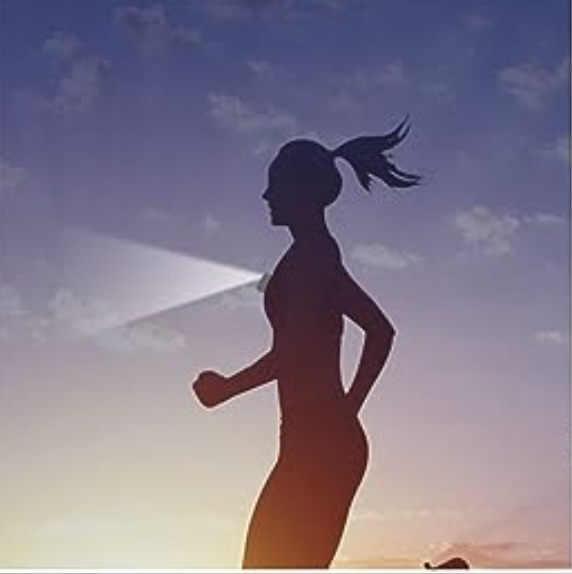
Light It ALL Up
Being a beacon of light isn’t just metaphorical advice. Ensure both you and your pup are also shining stars in the dark. With the market flooded with dog and human gear (see our Small Dog Walking Gear, below), opting for dog leads, harnesses and collars with lights and a lighted cross body strap for yourself is neither hard nor very expensive.
Night Stressors for Your Pup
The dark can be daunting for some of our small dogs. Unexpected encounters with other dogs might be more jarring and strange sounds might feel amplified at night. If your pup isn’t accustomed to dark walking, be sensitive to these potential fears.
Start with very short strolls. Bring treats, talk to her enthusiastically, and praise her every few minutes for her willingness to try new things.
Real Dangers Dog Walking in the Dark
Sometimes, fears are entirely rational. Not everyone lives in areas where walking at night is safe from a crime standpoint. And those of us in coyote or bear areas know well that dangerous run-ins are much more likely in pre-dawn or nighttime hours.
Be prepared with pepper spray or an air horn. Or, consider the “bear bells” I’ve linked below. A friend I’ve met through Instagram alerted me to them, and they’re supposed to help minimize the chances you’ll surprise a bear. She uses them on her leash, and while fortunately she’s never had to test their effectiveness, she says the sound is pleasant.
I did a bit of research on the bells, and they create quite a controversy in the hiking world, with competing studies showing bear bells do work, don’t work, or might actually ATTRACT bears. Since I’m less worried about bears and more about racoons and skunk, they’ll be a nice addition to my gear.
In any event, I realize whether you’re carrying pepper spray, air horns, or bear bells, each of these devices certainly inserts a screeching chalk sound through my vision of tranquil strolls under cover of dark. But, to borrow a British saying, “needs must….”
Parting Thoughts
Walking before dawn with Phoebe and Scout has improved my mindset on school days by about 20%. I’m also looking forward to dark evening walks when the clocks change in the coming month. And yet, stats like 76% of pedestrian collisions occurring in the dark should keep me (and all of us) vigilant. Let’s not be part of those stats, shall we?
Remember, whether day or night, our main goal (apart from making sure our dogs do their ‘business’) is to ensure safety. With a bit of caution, we can do that.
Nighttime Walks: A Checklist
🌙 Gear Up With Lights
- Wear reflective clothing and gear.
- Ensure your dog has a reflective harness, collar, or leash.
- Use a headlamp or carry a flashlight.
- Consider lighted dog leads and collars.
🚗 Stay Aware of Traffic
- Always face oncoming traffic when walking on roads without sidewalks.
- Cross streets at well-lit intersections or crosswalks.
- Be extra cautious around speeding vehicles.
👀 Maintain Visibility
- Stay on familiar, well-lit paths.
- Avoid dark alleyways or heavily wooded areas.
🎧 Limit Distractions
- Keep earbuds out to stay attuned to surrounding sounds.
- Avoid texting or calling while walking.
🐾 Be Mindful of Your Pup
- Pay attention to their behavior; they can often sense dangers before you do.
- Understand that the dark can be daunting for some dogs; be patient and comforting.
- Keep a shorter leash in busier areas for better control.
🦡 Know the Local Wildlife
- Be aware of any nocturnal animals in your area that could be threats, such as coyotes.
- Consider carrying an air horn or bear spray for potential threats.
📍 Stay Connected
- Let someone know your walking route.
- Share your live location with a family member or friend using your phone.
- Always carry a fully charged phone.
- Activate Siri or Google Assist in case you need to get help quickly.
👟 Mind Your Footing
- Be cautious of potential trip hazards like potholes or tree limbs.
- Avoid new routes or trails at night until you’ve familiarized yourself with them during the day.
🚫 Avoid Risky Areas
- Steer clear of places with a history of crime during nighttime hours.
- Stay aware of your surroundings and avoid engaging with suspicious individuals.
✅ Emergency Essentials
- Carry identification and any important medical information.
- Have a small first-aid kit for both you and your dog.
- Familiarize yourself with local emergency numbers and have them saved in your phone.
Print this checklist and keep it by the door as a handy reminder before you head out for your nighttime strolls. Safe walking!
Shopping List for Dog Walking in the Dark
You’ll Also Love
Leave a Reply
Your email address will not be published.




